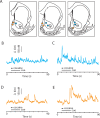Regional specificity in the real-time development of phasic dopamine transmission patterns during acquisition of a cue-cocaine association in rats
- PMID: 19912327
- PMCID: PMC2945681
- DOI: 10.1111/j.1460-9568.2009.07027.x
Regional specificity in the real-time development of phasic dopamine transmission patterns during acquisition of a cue-cocaine association in rats
Abstract
Drug seeking is significantly regulated by drug-associated cues and associative learning between environmental cues and cocaine reward is mediated by dopamine transmission within the nucleus accumbens (NAc). However, dopamine transmission during early acquisition of a cue-cocaine association has never been assessed because of the technical difficulties associated with resolving cue-evoked and cocaine-evoked dopamine release within the same conditioning trial. Here, we used fast-scan cyclic voltammetry to measure sub-second fluctuations in dopamine concentration within the NAc core and shell during the initial acquisition of a cue-cocaine Pavlovian association. Within the NAc core, cue-evoked dopamine release developed during conditioning. However, within the NAc shell, the predictive cue appeared to cause an unconditioned decrease in dopamine concentration. The pharmacological effects of cocaine also differed between sub-regions, as cocaine increased phasic dopamine release events within the NAc shell but not the core. Thus, real-time measurements not only revealed the initial development of a conditioned neurochemical response but also demonstrated differential phasic dopamine transmission patterns across NAc sub-regions during the acquisition of a cue-cocaine association.
Figures





Comment in
-
Regional specificity in dopamine signaling during reward-related learning (Commentary on Aragona et al.).Eur J Neurosci. 2009 Nov;30(10):1888. doi: 10.1111/j.1460-9568.2009.7036.x. Epub 2009 Nov 11. Eur J Neurosci. 2009. PMID: 19912326 No abstract available.
Similar articles
-
Aversive stimuli differentially modulate real-time dopamine transmission dynamics within the nucleus accumbens core and shell.J Neurosci. 2012 Nov 7;32(45):15779-90. doi: 10.1523/JNEUROSCI.3557-12.2012. J Neurosci. 2012. PMID: 23136417 Free PMC article.
-
Cue-Evoked Dopamine Release Rapidly Modulates D2 Neurons in the Nucleus Accumbens During Motivated Behavior.J Neurosci. 2016 Jun 1;36(22):6011-21. doi: 10.1523/JNEUROSCI.0393-16.2016. J Neurosci. 2016. PMID: 27251622 Free PMC article.
-
Preferential enhancement of dopamine transmission within the nucleus accumbens shell by cocaine is attributable to a direct increase in phasic dopamine release events.J Neurosci. 2008 Aug 27;28(35):8821-31. doi: 10.1523/JNEUROSCI.2225-08.2008. J Neurosci. 2008. PMID: 18753384 Free PMC article.
-
Phasic mesolimbic dopamine signaling encodes the facilitation of incentive motivation produced by repeated cocaine exposure.Neuropsychopharmacology. 2014 Sep;39(10):2441-9. doi: 10.1038/npp.2014.96. Epub 2014 May 7. Neuropsychopharmacology. 2014. PMID: 24804846 Free PMC article.
-
Differential dopamine release dynamics in the nucleus accumbens core and shell track distinct aspects of goal-directed behavior for sucrose.Neuropharmacology. 2012 Apr;62(5-6):2050-6. doi: 10.1016/j.neuropharm.2011.12.027. Epub 2012 Jan 12. Neuropharmacology. 2012. PMID: 22261383 Free PMC article.
Cited by
-
Aversive stimuli differentially modulate real-time dopamine transmission dynamics within the nucleus accumbens core and shell.J Neurosci. 2012 Nov 7;32(45):15779-90. doi: 10.1523/JNEUROSCI.3557-12.2012. J Neurosci. 2012. PMID: 23136417 Free PMC article.
-
Individual variation in the motivational properties of a nicotine cue: sign-trackers vs. goal-trackers.Psychopharmacology (Berl). 2015 Sep;232(17):3149-60. doi: 10.1007/s00213-015-3962-6. Epub 2015 May 19. Psychopharmacology (Berl). 2015. PMID: 25980485 Free PMC article.
-
Differential Dopamine Release Dynamics in the Nucleus Accumbens Core and Shell Reveal Complementary Signals for Error Prediction and Incentive Motivation.J Neurosci. 2015 Aug 19;35(33):11572-82. doi: 10.1523/JNEUROSCI.2344-15.2015. J Neurosci. 2015. PMID: 26290234 Free PMC article.
-
Effects of Social Housing on Electrically Stimulated Dopamine Release in the Nucleus Accumbens Core and Shell in Female and Male Rats.bioRxiv [Preprint]. 2025 Feb 26:2025.02.25.640103. doi: 10.1101/2025.02.25.640103. bioRxiv. 2025. PMID: 40060419 Free PMC article. Preprint.
-
Delays conferred by escalating costs modulate dopamine release to rewards but not their predictors.J Neurosci. 2010 Sep 8;30(36):12020-7. doi: 10.1523/JNEUROSCI.2691-10.2010. J Neurosci. 2010. PMID: 20826665 Free PMC article.
References
-
- Andersson JL, Nomikos GG, Marcus M, Hertel P, Mathe JM, Svensson TH. Ritanserin potentiates the stimulatory effects of raclopride on neuronal activity and dopamine release selectivity in the mesolimbic dopaminergic system. Naunyn Schmiedebergs Arch Pharmacol. 1995;352:374–385. - PubMed
-
- Bassareo V, De Luca MA, Di Chiara G. Differential impact of pavlovian drug conditioned stimuli on in vivo dopamine transmission in the rat accumbens shell and core and in the prefrontal cortex. Psychopharmacology (Berl) 2006 - PubMed
-
- Berke JD. Learning and memory mechanisms involved in compulsive drug use and relapse. Methods Mol Med. 2003;79:75–101. - PubMed
Publication types
MeSH terms
Substances
Grants and funding
LinkOut - more resources
Full Text Sources

